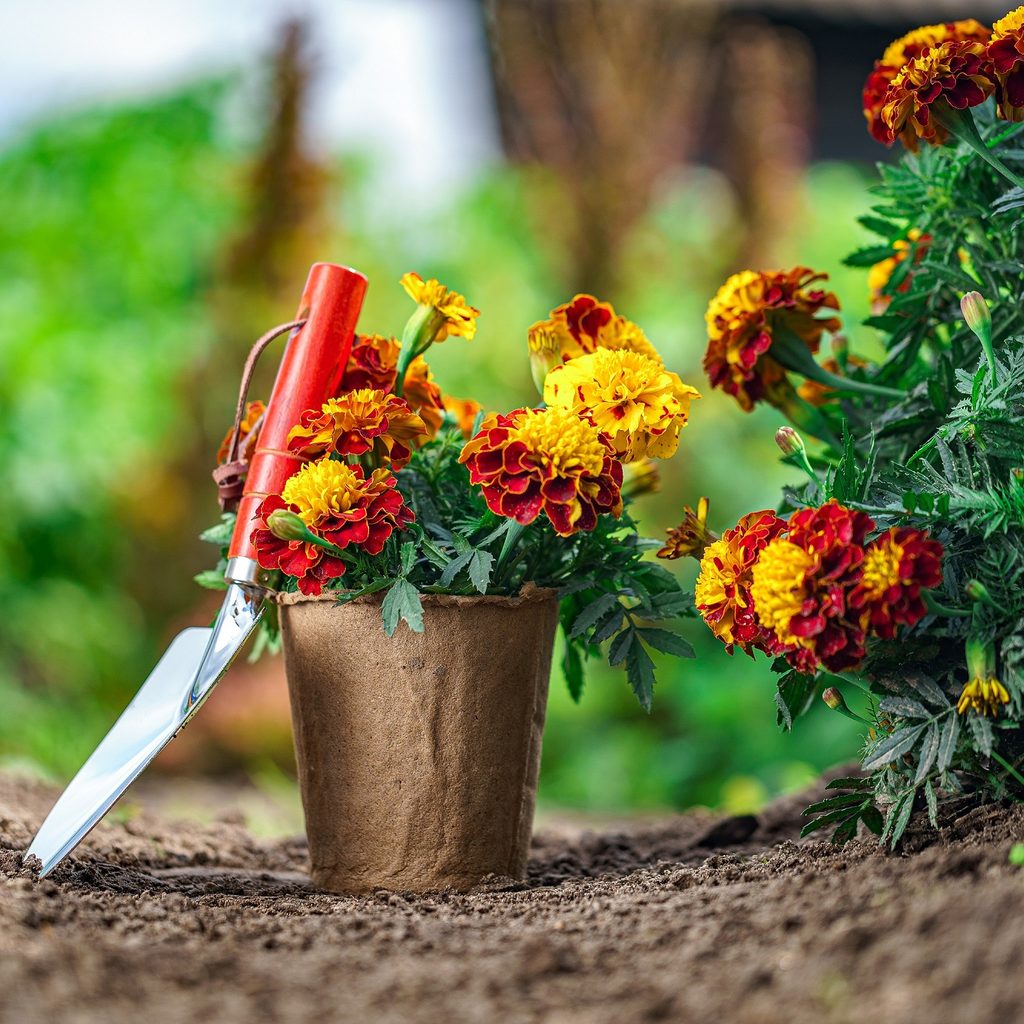Marigolds are beautiful flowers and suited to many types of gardens. These gold and red flowers are right at home in pollinator gardens, indoor gardens, and herb gardens, and they pair well with other edible flowers like nasturtium and rosemary shrubs. These lovely plants come in a range of sizes and offer many benefits. They can grow from seeds, but they’re also easy to find as seedlings or adult plants. If you’d like to add marigolds to your home or garden, then you’re in luck. We have everything you need to know to properly care for your marigolds in this simple guide.
Picking a variety
There are many varieties of marigolds to choose from, but a good place to start is by picking a marigold species. There are several, but the most common garden varieties belong to one of these species: Tagetes tenuifolia (signet or single marigolds), Tagetes patula (French marigolds), or Tagetes erecta (African or Aztec marigolds). You may also see pot marigold, or Calendula officinalis. Although it’s referred to as a marigold, and its flowers are a similar shade of orange, calendula is actually an unrelated plant.
Signet marigolds typically have smaller flowers. They’re called single marigolds because their flowers have only one layer of petals, unlike other marigold species, which have multiple layers. This gives their flowers a simpler, almost daisy-like appearance.
French marigolds and African marigolds are both native to Central America and South America, despite what their names imply. French marigolds have flatter flowers, with petals that have curled or crimped edges. They’re available in a wider color range, including many two-toned varieties. African marigolds are much larger, with puffier-looking flowers. They are most commonly a solid yellow or orange color.

Planting marigolds
Growing marigolds from seed is easy, no matter what species of marigold you’re planting. Although most care requirements don’t vary between marigold species, one major difference is planting time. African marigolds are slower to germinate and mature, so it’s best you plant them in early spring, right after the last winter frost has passed. You can speed up things by starting African marigolds indoors during the winter or by getting them as seedlings rather than seeds. Signet and French marigolds grow more quickly, so you can start them at any point in the spring or early summer.
Choose a planting location that’s in full sun. Marigolds thrive in hot, sunny weather, and too much shade can lead to fewer flowers. If you’re starting from seeds, dampen the ground before planting. You should plant seeds half an inch to an inch deep, and you can space them an inch apart and thin them later. If you’re transplanting seedlings, you should space them 8 to 10 inches apart for most varieties or 10 to 12 inches for African marigold varieties.

Caring for marigolds
Once they’re established, marigolds are easy to care for. They’re drought-tolerant plants, but don’t enjoy wet feet. If you live in an area with high rainfall, French marigolds are slightly more tolerant of excess water than African or signet marigolds. When watering marigolds; let the soil dry before watering them again. Additionally, avoid watering them from overhead. Frequently wet leaves can lead to powdery mildew. Instead, water between the plants and under the leaves.
You don’t need to deadhead marigolds, but it does encourage them to produce more flowers. You can gently pinch or clip off dying flowers, which you can eat, dry for display, or compost. Don’t leave dead flowers around your garden, as they can attract pests. While the plants are young, you can pinch the top off to encourage them to grow more horizontally rather than vertically. This leads to thicker, bushier plants rather than taller, spindly ones.

Benefits of growing marigolds
Aside from being stunning to look at; marigolds offer several benefits to gardens. Firstly, they’re edible. Both the flowers and the leaves are edible, and you can enjoy them raw or cooked. Many people enjoy adding marigolds to salads or using them as edible decorations for baked goods. Many people describe the flavor of marigolds as slightly citrusy and herbal.
Secondly, marigolds are great for attracting beneficial insects to your garden. Ladybugs, in particular, are fond of marigold pollen. Since ladybugs eat some harmful insects, including aphids and mites, adding marigolds to your garden can help protect your other flowers.
The gorgeous flowers are an excellent addition to any home or garden. Whether you prefer the small and sweet signet marigolds, the richly colored and elegant French marigolds, or the large and whimsical African marigolds, these flowers are sure to brighten your garden. You can even grow them in pots to bring a touch of the sun indoors with their brilliant red and gold colors.


